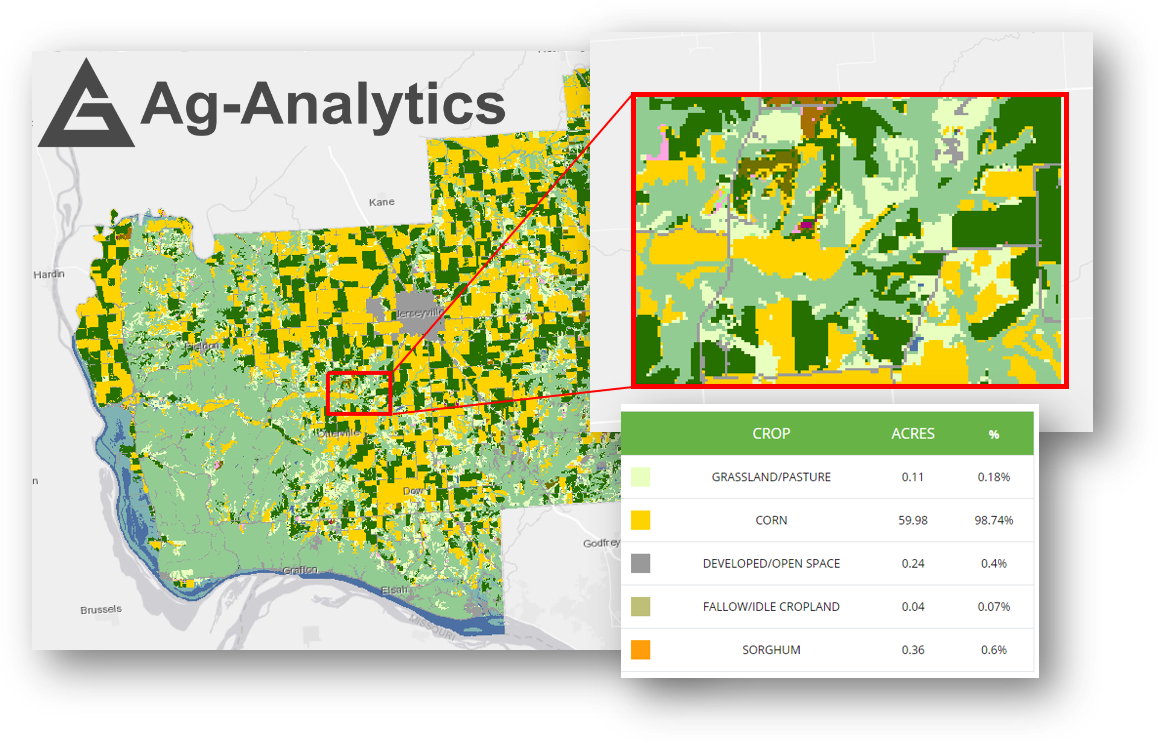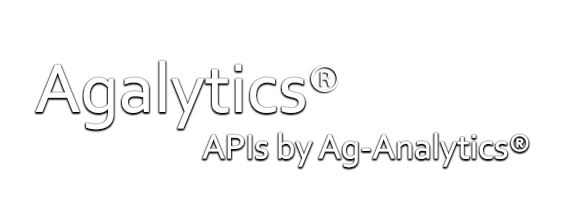Cropland Data Layers V2
Crop Land Data Layers, also known as CDLs, are published by USDA and provide estimates of historical crops cover.
Get Request Cropland Data Layers V2
Please note, you need to purchase a subscription key to call the API. Please use the trial version to try now for a limited amount of uses before purchase.
Powered by CROPAI™
The Cropland Data Layer (CDL), produced by the USDA, provides a raster, geo-referenced, crop-specific land cover map for the continental United States. The CDL also includes a crop mask layer and planting frequency layers, as well as boundary, water and road layers. The Boundary Layer options provided are County, Agricultural Statistics Districts (ASD), State, and Region. The data is created annually using moderate resolution satellite imagery and extensive agricultural ground truth.
The purpose of the Cropland Data Layer Program is to use satellite imagery to (1) provide planted acreage estimates to the Agricultural Statistics Board for each state's major commodities and (2) produce digital, crop-specific, categorized geo-referenced output products (Information from here).

Cropland Data Layers in Ag-Analytics DataLayers.
Click the Jupyter Notebook Static Sample to view a static rendition of this APIs Jupyter Notebook.
Click the Jupyter Notebook Github Repo to access the Jupyter Notebook .ipynb files and
instructions needed in order to run this APIs Jupyter Notebook.
GET Request
| Parameter | Description | Example | Request |
|---|---|---|---|
| filename | File name to download. From POST request. Only request a single file at a time. |
result_raster_cdl_CultivatedLayer_ epsg_4326_resolution_None_10270.tif |
https://ag-analytics.azure-api.net/cdl-range-read? filename=result_raster_cdl_CultivatedLayer_ epsg_4326_resolution_None_10270.tif |
Call API
Request
Request URL
Request parameters
Request headers
-
string
Request body
Responses
200 OK
Code samples
@ECHO OFF
curl -v -X GET "https://ag-analytics.azure-api.net/cdl-range-read/?filename={}"
-H "Ocp-Apim-Subscription-Key: {subscription key}"
--data-ascii "{body}"
using System;
using System.Net.Http.Headers;
using System.Text;
using System.Net.Http;
using System.Web;
namespace CSHttpClientSample
{
static class Program
{
static void Main()
{
MakeRequest();
Console.WriteLine("Hit ENTER to exit...");
Console.ReadLine();
}
static async void MakeRequest()
{
var client = new HttpClient();
var queryString = HttpUtility.ParseQueryString(string.Empty);
// Request headers
client.DefaultRequestHeaders.Add("Ocp-Apim-Subscription-Key", "{subscription key}");
// Request parameters
queryString["filename"] = "{}";
var uri = "https://ag-analytics.azure-api.net/cdl-range-read/?" + queryString;
var response = await client.GetAsync(uri);
}
}
} // // This sample uses the Apache HTTP client from HTTP Components (http://hc.apache.org/httpcomponents-client-ga/)
import java.net.URI;
import org.apache.http.HttpEntity;
import org.apache.http.HttpResponse;
import org.apache.http.client.HttpClient;
import org.apache.http.client.methods.HttpGet;
import org.apache.http.client.utils.URIBuilder;
import org.apache.http.impl.client.HttpClients;
import org.apache.http.util.EntityUtils;
public class JavaSample
{
public static void main(String[] args)
{
HttpClient httpclient = HttpClients.createDefault();
try
{
URIBuilder builder = new URIBuilder("https://ag-analytics.azure-api.net/cdl-range-read/");
builder.setParameter("filename", "{}");
URI uri = builder.build();
HttpGet request = new HttpGet(uri);
request.setHeader("Ocp-Apim-Subscription-Key", "{subscription key}");
// Request body
StringEntity reqEntity = new StringEntity("{body}");
request.setEntity(reqEntity);
HttpResponse response = httpclient.execute(request);
HttpEntity entity = response.getEntity();
if (entity != null)
{
System.out.println(EntityUtils.toString(entity));
}
}
catch (Exception e)
{
System.out.println(e.getMessage());
}
}
}
<!DOCTYPE html>
<html>
<head>
<title>JSSample</title>
<script src="http://ajax.googleapis.com/ajax/libs/jquery/1.9.0/jquery.min.js"></script>
</head>
<body>
<script type="text/javascript">
$(function() {
var params = {
// Request parameters
"filename": "{}",
};
$.ajax({
url: "https://ag-analytics.azure-api.net/cdl-range-read/?" + $.param(params),
beforeSend: function(xhrObj){
// Request headers
xhrObj.setRequestHeader("Ocp-Apim-Subscription-Key","{subscription key}");
},
type: "GET",
// Request body
data: "{body}",
})
.done(function(data) {
alert("success");
})
.fail(function() {
alert("error");
});
});
</script>
</body>
</html>
#import <Foundation/Foundation.h>
int main(int argc, const char * argv[])
{
NSAutoreleasePool * pool = [[NSAutoreleasePool alloc] init];
NSString* path = @"https://ag-analytics.azure-api.net/cdl-range-read/";
NSArray* array = @[
// Request parameters
@"entities=true",
@"filename={}",
];
NSString* string = [array componentsJoinedByString:@"&"];
path = [path stringByAppendingFormat:@"?%@", string];
NSLog(@"%@", path);
NSMutableURLRequest* _request = [NSMutableURLRequest requestWithURL:[NSURL URLWithString:path]];
[_request setHTTPMethod:@"GET"];
// Request headers
[_request setValue:@"{subscription key}" forHTTPHeaderField:@"Ocp-Apim-Subscription-Key"];
// Request body
[_request setHTTPBody:[@"{body}" dataUsingEncoding:NSUTF8StringEncoding]];
NSURLResponse *response = nil;
NSError *error = nil;
NSData* _connectionData = [NSURLConnection sendSynchronousRequest:_request returningResponse:&response error:&error];
if (nil != error)
{
NSLog(@"Error: %@", error);
}
else
{
NSError* error = nil;
NSMutableDictionary* json = nil;
NSString* dataString = [[NSString alloc] initWithData:_connectionData encoding:NSUTF8StringEncoding];
NSLog(@"%@", dataString);
if (nil != _connectionData)
{
json = [NSJSONSerialization JSONObjectWithData:_connectionData options:NSJSONReadingMutableContainers error:&error];
}
if (error || !json)
{
NSLog(@"Could not parse loaded json with error:%@", error);
}
NSLog(@"%@", json);
_connectionData = nil;
}
[pool drain];
return 0;
}
<?php
// This sample uses the Apache HTTP client from HTTP Components (http://hc.apache.org/httpcomponents-client-ga/)
require_once 'HTTP/Request2.php';
$request = new Http_Request2('https://ag-analytics.azure-api.net/cdl-range-read/');
$url = $request->getUrl();
$headers = array(
// Request headers
'Ocp-Apim-Subscription-Key' => '{subscription key}',
);
$request->setHeader($headers);
$parameters = array(
// Request parameters
'filename' => '{}',
);
$url->setQueryVariables($parameters);
$request->setMethod(HTTP_Request2::METHOD_GET);
// Request body
$request->setBody("{body}");
try
{
$response = $request->send();
echo $response->getBody();
}
catch (HttpException $ex)
{
echo $ex;
}
?>########### Python 2.7 #############
import httplib, urllib, base64
headers = {
# Request headers
'Ocp-Apim-Subscription-Key': '{subscription key}',
}
params = urllib.urlencode({
# Request parameters
'filename': '{}',
})
try:
conn = httplib.HTTPSConnection('ag-analytics.azure-api.net')
conn.request("GET", "/cdl-range-read/?%s" % params, "{body}", headers)
response = conn.getresponse()
data = response.read()
print(data)
conn.close()
except Exception as e:
print("[Errno {0}] {1}".format(e.errno, e.strerror))
####################################
########### Python 3.2 #############
import http.client, urllib.request, urllib.parse, urllib.error, base64
headers = {
# Request headers
'Ocp-Apim-Subscription-Key': '{subscription key}',
}
params = urllib.parse.urlencode({
# Request parameters
'filename': '{}',
})
try:
conn = http.client.HTTPSConnection('ag-analytics.azure-api.net')
conn.request("GET", "/cdl-range-read/?%s" % params, "{body}", headers)
response = conn.getresponse()
data = response.read()
print(data)
conn.close()
except Exception as e:
print("[Errno {0}] {1}".format(e.errno, e.strerror))
####################################require 'net/http'
uri = URI('https://ag-analytics.azure-api.net/cdl-range-read/')
query = URI.encode_www_form({
# Request parameters
'filename' => '{}'
})
if query.length > 0
if uri.query && uri.query.length > 0
uri.query += '&' + query
else
uri.query = query
end
end
request = Net::HTTP::Get.new(uri.request_uri)
# Request headers
request['Ocp-Apim-Subscription-Key'] = '{subscription key}'
# Request body
request.body = "{body}"
response = Net::HTTP.start(uri.host, uri.port, :use_ssl => uri.scheme == 'https') do |http|
http.request(request)
end
puts response.body
